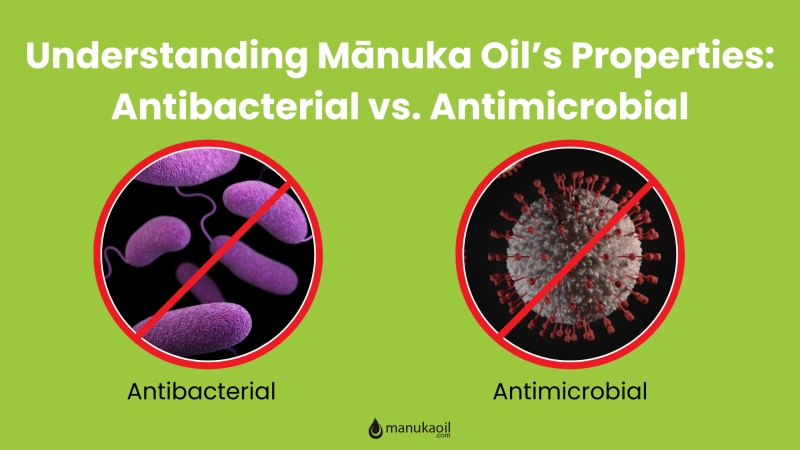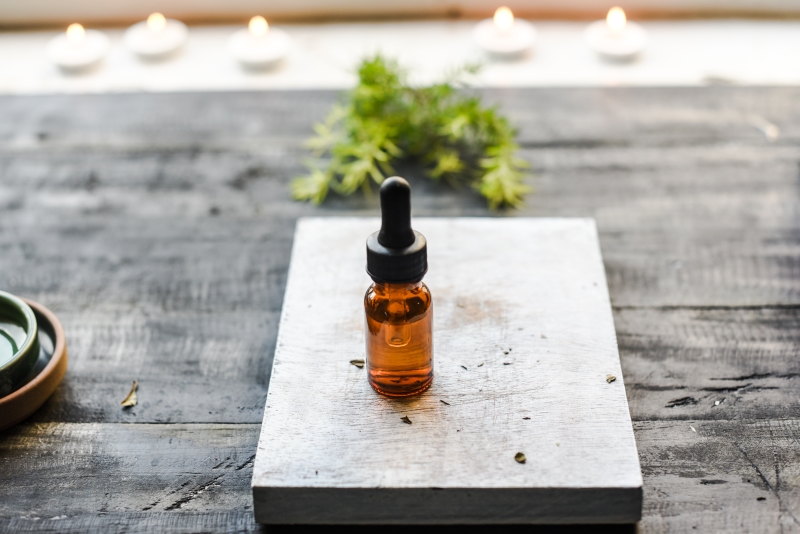Mānuka oil is well known for its antimicrobial and antibacterial properties. It is crucial to recognise each property’s contribution to mānuka oil’s effectiveness as a potent natural remedy for different skin conditions, hair health, wounds, pet care, and how it can be used for aromatherapy.
Getting to Know Mānuka Oil
Mānuka oil is an essential oil extracted from the mānuka plant, scientifically known as Leptospermum scoparium, a species with a long history of traditional use by indigenous communities in New Zealand and Australia spanning centuries.
Leptospermum scoparium is the sole Leptospermum species native to New Zealand, exhibiting a size range from a creeping plant to a small tree reaching a height of 8 meters. It is widely distributed across various climatic and altitudinal zones in New Zealand. Physical characteristics, including flower and leaf colour, leaf size and shape, branching habit, and foliage density, exhibit significant variation among populations.
In ancient times, Māori, Aboriginals, and early European settlers used mānuka oil to treat wounds, cuts, sores, and skin diseases. Additionally, they employed it as inhalations to address colds and fevers.
Oil, extracted from the tips and leaves of the mānuka bush, has been proven to contain specific constituents with various medicinal properties.
According to Down Under Enterprises, mānuka oil exhibits a microbial kill rate of 99.9%, surpassing Tea Tree Oil by up to 1500 times for gram-positive bacteria.
Phil Prather, Head of Marketing and Operations at Down Under Enterprises, notes that while the antimicrobial potential of tea tree oil is widely acknowledged, the antimicrobial properties of mānuka oil are only beginning to gain recognition. Mānuka oil demonstrates the most effective inhibitory effects on Gram-positive bacteria and dermatophytes, attributed to its content of β-triketones.
Antibacterial and Antimicrobial Differences

What Does Antibacterial Mean?
An antibacterial substance hinders the growth or eradicates bacterial cells, preventing the spread of illnesses caused by bacteria such as:
- E. coli
- Shigella
- Salmonella
Antibacterial products exclusively target bacterial growth and dissemination, lacking efficacy against fungi and viruses. These products incorporate active ingredients that establish hostile environments unsuitable for bacterial survival.
What Does Antimicrobial Mean?
An antimicrobial substance is designed to eliminate or impede the growth of various microorganisms, including bacteria, fungi, and viruses. They also exhibit effectiveness against specific parasites and mites, such as house dust mites.
Antimicrobials protect against various illnesses and infections, including those caused by:
- Coronavirus
- Influenza
- Ebola
- The common cold
Antimicrobials operate at a cellular level and halt the growth of diverse microorganisms that would otherwise replicate and lead to infections.
Antimicrobial products incorporate agents, such as silver ions, which serve as a defence against microorganisms. These silver ions attach themselves to a cell’s proteins, disrupt its DNA, and impede its respiratory system. Consequently, this halts the cell’s energy production, leading to its rupture.
Do antimicrobials kill bacteria?
Antimicrobial substances can disrupt essential life processes in a wide range of microbes, including bacteria. When bacteria interact with a surface treated with antimicrobial technology, the antimicrobial employs a multi-modal attack, damaging the cell’s protein, membrane, DNA, and internal systems. This disruption of the cell structure disables its ability to reproduce and survive.
Does antimicrobial also mean antifungal?
Antimicrobial substances work against a broad spectrum of microbes and can have antifungal and antibacterial properties. The active ingredient in the substance will determine if it is antibacterial, antifungal, or both.
Is antimicrobial better than antibacterial?
Antimicrobial substance demonstrates efficacy against a variety of bacteria and fungi. Nevertheless, opting for an antibacterial solution may be more suitable when fungal activity is not a relevant consideration for the intended product. The choice between the two depends on the end-use environment and specific objectives for their antimicrobial effect.
Which is Better: Antimicrobial or Antibacterial?
Antimicrobials hold an advantage as they are effective against a broad spectrum of microbes, encompassing bacteria, mould, fungi, and viruses. In contrast, antibacterials specifically target bacteria. The extended protection offered by antimicrobials, continuously inhibiting microbial growth on surfaces for an extended period, enhances their effectiveness. Despite this distinction, both antimicrobials and antibacterials effectively eliminate germs.
Mānuka Oil’s Antibacterial and Antimicrobial Properties

Mānuka oil demonstrates high efficacy against a broad spectrum of bacteria responsible for skin, soft tissue, and other infections as shown in the tables below.
Mānuka oil’s antimicrobial and antibacterial properties contribute to its healing effects on various types of bacteria. The antimicrobial aspect of mānuka oil implies its ability to combat a wide range of microorganisms, including bacteria. This broad-spectrum action inhibits the growth and development of different bacterial strains.
On the other hand, the antibacterial properties specifically target bacteria, disrupting their vital processes and inhibiting their proliferation. The combination of these properties allows mānuka oil to exert a healing influence on diverse bacterial infections by impeding their growth, promoting recovery, and contributing to overall therapeutic effects.
The Minimum Inhibitory Concentration (MIC) is the lowest concentration of an antimicrobial that prevents visible growth of a microorganism after an overnight incubation. MICs are regarded as the “gold standard” for assessing the susceptibility of organisms to antimicrobials.
A lower MIC value signifies that a smaller amount of concentration is needed to inhibit the growth of the organism. Consequently, essential oils with lower MIC scores are deemed more effective as antimicrobial agents.
Activity of Mānuka Oil Against Gram-Positive Bacteria
| Organism (Gram) | MIC % | Data | Relevance |
| S. aureus | 0.078-0.125 | PF | Skin & wound infections |
| MRSA * | 0.02-0.06 | PF | Skin & wound infections |
| C. acnes | 0.07 | PF | Acne |
| S. epidermidis | 0.05-0.078 | PF | Acne, wound infections |
| S. pyogenes | 0.125 | PF | Skin & wound infections |
| E. faecalis * | 0.039
0.0064 |
PF
M |
Open wound infections |
| E. faecium | 0.05 | PF | Cellulitis, wound infections |
| S. agalactiae | 0.039 | PF | Abscesses, UTIs, septicaemia |
| S. lutea | 0.078 | PF | Gastric ulcers |
| S. capitis | 0.05 | PF | Cellulitis, other |
| C. diphtheriae | 0.05 | PF | Skin & throat infections |
| C. minutissimum | 0.05 | PF | Erythrasma |
| B. subtilis | 0.156
0.03 |
PF
M |
Immunocompromised infections |
| L. monocytogenes | 0.039 | PF | Sepsis, meningitis & other |
| Peptostreptococcus spp | 0.07 | PF | Skin, soft tissue & other |
| A. vaginae | 0.001 | M | Vaginal infections |
| B. vulgatus | 0.001 | M | Vaginal infections |
| G. vaginalis | 0.001 | M | Vaginal infections |
| Methicillin- resistant
S. pseudintermedius* |
0.002% – 0.0156 | S | Veterinary infections |
| methicillin-susceptible S. pseudintermedius | 0.002% -0.0078 | S | Veterinary infections |
| S. sobrinus | 0.048, 0.13, 0.25 | M | Oral infections |
| S. mutans | 0.25 | M | Oral infections |
Sources: PF = Plant & Food; M = Mathew et al. (2020), S = Song et al. (2013), * = Drug resistant pathogens
NOTE: The lower the MIC, the more effective the antimicrobial against a given pathogen
Activity of Mānuka Oil Against Gram-Negative Bacteria
| Organism (Gram) | MIC % | Data | Relevance |
| A. actinomycetemcomitans | 0.03 | M | Oral infections |
| P. gingivalis | 0.03 | M | Oral infections |
| F. nucleatum | 0.03 | Periodontal disease | |
| K. pneumoniae * | 2-4 | M | Hospital based infections |
| E. coli | 1-4 | M | Hospital based infections |
| P. mirabilis | 1-4 | M | Hospital based infections |
| P. vulgaris | 0.5 – >2 | PF | Wound and burn infections |
| P. aeruginosa | 0.85 -2.5 | PF | Hospital infections, burn, and wound infections |
| S. typhimurium | 0.00236 | M | Gastroenteritis |
| S. flexneri | 0.00653 | M | Bacterial dysentery |
| S. sonnei | 0.00697 | M | Bacterial dysentery |
Sources: PF = Plant & Food; M = Mathew et al. (2020), S = Song et al. (2013), * = Drug resistant pathogens
NOTE: The lower the MIC, the more effective the antimicrobial against a given pathogen
MIC Data on Mānuka Oil & Tea Tree Oil
This data indicates that mānuka oil has significantly stronger and broader-spectrum antimicrobial properties than tea tree oil.
| No. | Pathogen | Mānuka Oil | Tea Tree Oil |
| Gram Negative Bacteria | |||
| 1 | P. vulgaris | 0.50 | 0.30 |
| 2 | P. aeruginosa | 0.85 | 1.0 |
| 3 | E. coli | >2 | 0.25 |
| Gram Positive Bacteria | |||
| 4 | S. aureus | 0.10 | 0.25 |
| 5 | MRSA | 0.05 | 0.35 |
| 6 | S. Capitis | 0.05 | 0.35 |
| 7 | S. epidermidis | 0.05 | 0.45 |
| 8 | E. faecium | 0.05 | 0.25 |
| 9 | B. Subtilis | 0.15 | 0.30 |
| 10 | C. diphtheriae | 0.05 | 0.20 |
| 11 | C. minutissimus | 0.05 | 0.20 |
| Fungi & Yeasts | |||
| 12 | C. albicans | >2 | 0.30 |
| 13 | E. floccosum | 0.4 | 0.70 |
| 14 | T. rubrum | 0.3 | 0.60 |

